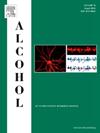产前乙醇和产后青少年乙醇暴露的协同作用分析
IF 2.9
4区 医学
Q3 PHARMACOLOGY & PHARMACY
引用次数: 0
摘要
产前乙醇暴露(PEE)与长期的神经发育改变有关,增加了不良行为结果的易感性,包括青春期酗酒的可能性更大。然而,这两种发育风险因素的相互作用仍未得到充分探讨。本研究探讨了PEE和青少年酒精暴露对Wistar大鼠行为和酒精消费模式的协同影响。从妊娠第17-20天开始,孕鼠接受乙醇(2.0 g/kg/天)或载药。子代从出生后23-36天开始接受间歇乙醇暴露(4.0 g/kg/天,开两天,休息两天)或车辆。行为评估包括焦虑样行为(光-暗盒测试)、快感缺乏(蔗糖偏好测试)、探索性行为(多变量同心方场测试)和成年早期的自愿乙醇消费测试。PEE与总液体消耗量增加(p = 0.001, η2p = 0.17)和乙醇摄入量增加(p = 0.001, η2p = 0.05)相关。PEE大鼠表现出较低的蔗糖偏好(p = 0.02, η2p = 0.07),提示一种与青春期乙醇暴露无关的快感缺乏样表型。后一种暴露诱发了焦虑表型,其特征是在明暗箱试验的光照室中停留的时间减少,在pee暴露的大鼠中这种情况有所减弱(p = 0.03, η2p = 0.06)。这些发现表明,PEE (a)可能通过耐受性机制或改变化学感觉加工促进后代对乙醇的消耗;(b)调节青少年酒精暴露诱导的焦虑样行为。了解这些相互作用对于阐明酒精使用障碍的机制和为高危人群设计有针对性的干预措施至关重要。本文章由计算机程序翻译,如有差异,请以英文原文为准。
Analysis of the synergy between prenatal ethanol and postnatal adolescent ethanol exposure
Prenatal ethanol exposure (PEE) is associated with long-lasting neurodevelopmental alterations that increase susceptibility to adverse behavioral outcomes, including greater likelihood of binge drinking during adolescence. However, the interactive effects of these two developmental risk factors remain underexplored. The present study investigated the synergistic impact of PEE and adolescent binge-like ethanol exposure on behavioral and ethanol consumption patterns in Wistar rats. Pregnant dams received ethanol (2.0 g/kg/day) or vehicle from gestational days 17–20. Offspring were subjected to intermittent ethanol exposure (4.0 g/kg/day, two days on–two days off) or vehicle from postnatal days 23–36. Behavioral assessments included tests for anxiety-like behaviors (light–dark box test), anhedonia (sucrose preference test), exploratory behavior (multivariate concentric square field test), and voluntary ethanol consumption in early adulthood. PEE was associated with increased overall fluid consumption (p = 0.001, η2p = 0.17) and a sex-dependent increase in ethanol intake (p = 0.001, η2p = 0.05). PEE rats displayed reduced sucrose preference (p = 0.02, η2p = 0.07), suggesting an anhedonic-like phenotype independent of adolescent ethanol exposure. The latter exposure induced an anxious phenotype, characterized by reduced time in the illuminated compartment of the light–dark box test, which was attenuated in PEE-exposed rats (p = 0.03, η2p = 0.06). These findings suggest that PEE (a) facilitates ethanol consumption in offspring, potentially through tolerance mechanisms or altered chemosensory processing; and (b) modulates anxiety-like behaviors induced by adolescent ethanol exposure. Understanding these interactions is critical for elucidating the mechanisms underlying alcohol use disorders and designing targeted interventions for at-risk populations.
求助全文
通过发布文献求助,成功后即可免费获取论文全文。
去求助
来源期刊

Alcohol
医学-毒理学
CiteScore
4.60
自引率
4.30%
发文量
74
审稿时长
15.6 weeks
期刊介绍:
Alcohol is an international, peer-reviewed journal that is devoted to publishing multi-disciplinary biomedical research on all aspects of the actions or effects of alcohol on the nervous system or on other organ systems. Emphasis is given to studies into the causes and consequences of alcohol abuse and alcoholism, and biomedical aspects of diagnosis, etiology, treatment or prevention of alcohol-related health effects.
Intended for both research scientists and practicing clinicians, the journal publishes original research on the neurobiological, neurobehavioral, and pathophysiological processes associated with alcohol drinking, alcohol abuse, alcohol-seeking behavior, tolerance, dependence, withdrawal, protracted abstinence, and relapse. In addition, the journal reports studies on the effects alcohol on brain mechanisms of neuroplasticity over the life span, biological factors associated with adolescent alcohol abuse, pharmacotherapeutic strategies in the treatment of alcoholism, biological and biochemical markers of alcohol abuse and alcoholism, pathological effects of uncontrolled drinking, biomedical and molecular factors in the effects on liver, immune system, and other organ systems, and biomedical aspects of fetal alcohol spectrum disorder including mechanisms of damage, diagnosis and early detection, treatment, and prevention. Articles are published from all levels of biomedical inquiry, including the following: molecular and cellular studies of alcohol''s actions in vitro and in vivo; animal model studies of genetic, pharmacological, behavioral, developmental or pathophysiological aspects of alcohol; human studies of genetic, behavioral, cognitive, neuroimaging, or pathological aspects of alcohol drinking; clinical studies of diagnosis (including dual diagnosis), treatment, prevention, and epidemiology. The journal will publish 9 issues per year; the accepted abbreviation for Alcohol for bibliographic citation is Alcohol.
 求助内容:
求助内容: 应助结果提醒方式:
应助结果提醒方式:


